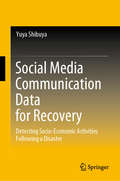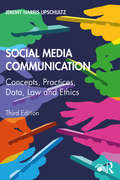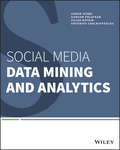- Table View
- List View
Social Media Commerce For Dummies
by Marsha CollierCapture customers and sales with social media commerceSocial media commerce is a booming industry. By using social networks in the context of e-commerce transactions, brands large and small are making their products more available and more convenient for customers. This one-of-a-kind guide introduces you to social media commerce and explains how you can use social media to provide better customer service, collect payments online, and build your customer base. Online marketing expert Marsha Collier helps you determine where you have the best opportunity to reach your market, which sites you should integrate with, and much more.Your customers are communicating with each other via social media; making purchasing opportunities available on social media sites adds convenience for your customer and opens up new sales opportunities This step-by-step guide explains social media commerce and shows what you can accomplish Helps you determine the sites where your business should have a presence Demonstrates how customers can help promote your brand as they recommend products and services to others on their social networks Author Marsha Collier is the undisputed expert on eBay and a recognized authority on social media marketingSocial Media Commerce For Dummies helps you offer your customers better service while giving them the opportunity to share information about your product with their social media contacts.
Social Media Communication Data for Recovery: Detecting Socio-Economic Activities Following a Disaster
by Yuya ShibuyaThis book explores the possibility of using social media data for detecting socio-economic recovery activities. In the last decade, there have been intensive research activities focusing on social media during and after disasters. This approach, which views people’s communication on social media as a sensor for real-time situations, has been widely adopted as the “people as sensor” approach. Furthermore, to improve recovery efforts after large-scale disasters, detecting communities’ real-time recovery situations is essential, since conventional socio-economic recovery indicators, such as governmental statistics, are not published in real time. Thanks to its timeliness, using social media data can fill the gap. Motivated by this possibility, this book especially focuses on the relationships between people’s communication on Twitter and Facebook pages, and socio-economic recovery activities as reflected in the used-car market data and the housing market data in the case of two major disasters: the Great East Japan Earthquake and Tsunami of 2011 and Hurricane Sandy in 2012. The book pursues an interdisciplinary approach, combining e.g. disaster recovery studies, crisis informatics, and economics. In terms of its contributions, firstly, the book sheds light on the “people as sensors” approach for detecting socio-economic recovery activities, which has not been thoroughly studied to date but has the potential to improve situation awareness during the recovery phase. Secondly, the book proposes new socio-economic recovery indicators: used-car market data and housing market data. Thirdly, in the context of using social media during the recovery phase, the results demonstrate the importance of distinguishing between social media data posted both by people who are at or near disaster-stricken areas and by those who are farther away.
Social Media Communication: Concepts, Practices, Data, Law and Ethics
by Jeremy Harris LipschultzIn Social Media Communication: Concepts, Practices, Data, Law and Ethics, Jeremy Harris Lipschultz presents a wide-scale, interdisciplinary analysis and guide to social media. Examining platforms such as Twitter, Facebook, LinkedIn, Pinterest, Youtube and Vine, the book explores and analyzes journalism, broadcasting, public relations, advertising and marketing. Lipschultz focuses on key concepts, best practices, data analyses, law and ethics--all promoting the critical thinking professionals and students need to use new networking tools effectively and to navigate social and mobile media spaces. Featuring contemporary case studies, essays from some of the industry's leading social media innovators, and a comprehensive glossary, this practical, multipurpose textbook gives readers the resources they'll need to both evaluate and utilize current and future forms of social media. For more information about the book, supplementary updates and teaching materials, follow Social Media Communication online at: Facebook: https://www.facebook.com/SocialMediaCommunication Twitter: @JeremyHL #smc2015 SlideShare: http://www.slideshare.net/jeremylipschultz
Social Media Communication: Concepts, Practices, Data, Law and Ethics
by Jeremy Harris LipschultzIn the second edition of Social Media Communication: Concepts, Practices, Data, Law and Ethics, Jeremy Harris Lipschultz presents a wide-scale, interdisciplinary analysis and guide to social media. Examining platforms such as Facebook, Instagram, Snapchat, LinkedIn, YouTube and Pinterest, this book explores and analyzes journalism, broadcasting, public relations, advertising and marketing. Lipschultz focuses on key concepts, best practices, data analyses, law and ethics—all promoting the critical thinking professionals and students need to use new networking tools effectively and to navigate social and mobile media spaces. Featuring historical markers and contemporary case studies, essays from some of the industry’s leading social media innovators and a comprehensive glossary, this practical, multipurpose textbook gives readers the resources they’ll need to both evaluate and utilize current and future forms of social media. For more information about the book, supplementary updates and teaching materials, follow the Social Media Communication Facebook page, @JeremyHL on Twitter and the UNO Social Media Lab on SlideShare. Facebook: www.facebook.com/SocialMediaCommunication Twitter: @JeremyHL #UNOSML #SMC2018 #SMProfs SlideShare: www.slideshare.net/jeremylipschultz
Social Media Communication: Concepts, Practices, Data, Law and Ethics
by Jeremy Harris LipschultzThis updated third edition presents a wide-scale, interdisciplinary guide to social media. Examining platforms like Facebook, Instagram, LinkedIn, Snapchat, TikTok, Twitter and YouTube, the book analyzes social media's use in journalism, broadcasting, public relations, advertising and marketing. Lipschultz focuses on key concepts, best practices, data analyses, law and ethics – all promoting the critical thinking that is needed to use new, evolving and maturing networking tools effectively within social and mobile media spaces. Featuring historical markers and contemporary case studies, essays from some of the industry’s leading social media innovators and a comprehensive glossary, this practical, multipurpose textbook gives readers the resources they will need to both evaluate and utilize current and future forms of social media communication. Among other changes, updates to the third edition include a deep dive into new approaches to analytics, as well as greater discussion of law and ethics in light of the Facebook Cambridge Analytica scandal, the roll-out of GDPR and new case law relating to social media. Social Media Communication is the perfect social media primer for students and professionals, and, with a dedicated teaching guide, ideal for instructors, too.
Social Media Communication: Concepts, Practices, Data, Law and Ethics
by Jeremy Harris LipschultzThis updated fourth edition presents a wide-scale, interdisciplinary guide to social media communication. Examining platforms like Facebook, Instagram, Snapchat, TikTok, Twitter and YouTube, the book analyzes social media's use in journalism, public relations, advertising and marketing. Lipschultz focuses on key concepts, best practices, data analyses, law and ethics – all promoting the critical thinking that is needed to use new, evolving and maturing networking tools effectively within social and mobile media spaces. Featuring historical markers and contemporary case studies, essays from some of the industry’s leading social media innovators and a comprehensive glossary, this practical, multipurpose textbook gives readers the resources they will need to both evaluate and utilize current and future forms of social media communication. Updates to the fourth edition include expanded discussion of disinformation, the impact of artificial intelligence (AI), natural language chatbots, virtual and augmented reality technologies and the COVID-19 infodemic. Social Media Communication is the perfect social media primer for students and professionals and, with a dedicated online teaching guide, ideal for instructors, too.
Social Media Data Mining and Analytics
by Antonios Chalkiopoulos Gabor Szabo Gungor Polatkan P. Oscar BoykinHarness the power of social media to predict customer behavior and improve sales Social media is the biggest source of Big Data. Because of this, 90% of Fortune 500 companies are investing in Big Data initiatives that will help them predict consumer behavior to produce better sales results. Written by Dr. Gabor Szabo, a Senior Data Scientist at Twitter, and Dr. Oscar Boykin, a Software Engineer at Twitter, Social Media Data Mining and Analytics shows analysts how to use sophisticated techniques to mine social media data, obtaining the information they need to generate amazing results for their businesses. Social Media Data Mining and Analytics isn't just another book on the business case for social media. Rather, this book provides hands-on examples for applying state-of-the-art tools and technologies to mine social media - examples include Twitter, Facebook, Pinterest, Wikipedia, Reddit, Flickr, Web hyperlinks, and other rich data sources. In it, you will learn: The four key characteristics of online services-users, social networks, actions, and content The full data discovery lifecycle-data extraction, storage, analysis, and visualization How to work with code and extract data to create solutions How to use Big Data to make accurate customer predictions Szabo and Boykin wrote this book to provide businesses with the competitive advantage they need to harness the rich data that is available from social media platforms.
Social Media Design For Dummies
by Janine Warner David LafontaineLearn to design professional and effective social media profiles!Whether you're trying to attract a new employer or get new fans to notice your brand, your social media profiles need to distinguish you from the masses. Packed with the secrets behind the hottest Facebook timelines, Twitter backgrounds, and LinkedIn profiles, this fun-but-straightforward guide shows you how to create eye-catching social media profiles with a professional, cohesive design.Includes online resources and downloadable templates that allow you to make your own profiles quick and easyReveals techniques for making a memorable and unique Twitter background, Facebook profile and page, LinkedIn profile, Google+ profile, and moreDetails ways in which to use Pinterest boards and cover photos to showcase your brandShows you how to make the most of Rebelmouse and YouTube.Social Media Design For Dummies is a must-have introductory guide to creating a professional, effective, and cohesive design that will better communicate your brand's story to future partners, employers, and customers.
Social Media For Small Business: Marketing Strategies for Business Owners
by Franziska IseliDiscover how social media can transform your business and help you attract more customers Social Media For Small Business delivers a step-by-step guide to unlocking the potential of social media to grow your business. Award-winning author and entrepreneur Franziska Iseli walks you through how to use Facebook, LinkedIn, Instagram, YouTube, Twitter, and Pinterest to market your small-to medium-sized business. The book provides you with: Effective marketing strategies to get more out of your social media efforts. Systems to bring structure into your entire marketing approach. Tools to make your brand irresistible across your customer touchpoints. Case studies to highlight the application of the book’s principles to the real-world Practical strategies you can put in place immediately to see a rapid return on investment Perfect for busy business owners, business managers and marketing teams wanting to find new and effective marketing tools to attract more customers, Social Media For Small Business also belongs on the bookshelves of anyone who has difficulty with or wants to learn more about how social media can have a positive impact on their business and brand.
Social Media Generation in Urban China
by Hanyun HuangSocial media such as instant messaging (IM), social networking sites (SNS), blogs and microblogs are an integral part of adolescents' lives in China. Anecdotal evidence reported in the news has suggested that the increasing popularity of social media could make adolescents more vulnerable to being addicted. This exploratory study proposes the concept of "social media addiction" and examines (a) whether social media addiction exists among adolescents in urban China and, if so, who the addicts are, what their symptoms are and to what extent they are addicted; (b) whether sociopsychological traits (e. g. , need for affiliation, impression management, narcissism and leisure boredom) can predict social media addiction among adolescents; (c) what gratifications are obtained by adolescents from their use of social media and whether these gratifications can predict social media addiction and (d) to what degree social media addiction influences adolescents' academic performance and social capital. This study employed quantitative questionnaire surveys among adolescents as the main research method, supplemented by qualitative pre-survey focus groups among adolescents and post-survey in-depth interviews among parents and teachers. Questionnaire surveys were conducted based on a multi-stage cluster sampling of seven middle schools in five urban Chinese cities: Beijing, Shanghai, Guangzhou, Shenzhen and Xiamen. The final sample consisted of 1,549 adolescents, of whom 90% had used social media. Using Young's classic definition of Internet addiction, 15. 6% of participants were classified as social media addicts. The addicted adolescents were often self-absorbed, bored with their leisure time, and good at using manipulation through social media for impression management. Addicts experienced four major social media addiction symptoms: preoccupation, adverse consequences, alleviation of negative emotions and loss of interest in social activities. The seven social media gratifications identified in this study can be categorized into social, information and entertainment gratifications. Among these, entertainment gratifications had the most power to predict social media addiction, while information gratifications were the least likely to lead to addiction. Furthermore, these gratifications were found to be powerful mediators between the adolescents' sociopsychological traits and social media addiction. Finally, the results also indicated that social media addiction and its symptoms had a significant negative impact on adolescents' academic performance and social capital.
Social Media Impacts on Conflict and Democracy: The Techtonic Shift (Routledge Advances in International Relations and Global Politics)
by Lisa SchirchSocial media technology is having a dramatic impact on social and political dynamics around the world. The contributors to this book document and illustrate this "techtonic" shift on violent conflict and democratic processes. They present vivid examples and case studies from countries in Africa, South and Southeast Asia, Latin America as well as Northern Ireland. Each author maps an array of peacebuilding solutions to social media threats, including coordinated action by civil society, governments and tech companies to protect human minds, relationships and institutions. Solutions presented include inoculating society with a new digital literacy agenda, designing technology for positive social impacts, and regulating technology to prohibit the worst behaviours. A must-read both for political scientists and policymakers trying to understand the impact of social media, and media studies scholars looking for a global perspective.
Social Media Intelligence
by Wendy W. Moe David A. SchweidelIn the world of Facebook, Twitter and Yelp, water-cooler conversations with co-workers and backyard small talk with neighbors have moved from the physical world to the digital arena. In this new landscape, organizations ranging from Fortune 500 companies to government agencies to political campaigns continuously monitor online opinions in an effort to guide their actions. Are consumers satisfied with our product? How are our policies perceived? Do voters agree with our platform? Measuring online opinion is more complex than just reading a few posted reviews. Social media is replete with noise and chatter that can contaminate monitoring efforts. By knowing what shapes online opinions, organizations can better uncover the valuable insights hidden in the social media chatter and better inform strategy. This book can help anyone facing the challenge of making sense of social media data to move beyond the current practice of social media monitoring to more comprehensive use of social media intelligence.
Social Media Investigation for Law Enforcement
by Joshua Brunty Katherine HelenekSocial media is becoming an increasingly important—and controversial—investigative source for law enforcement. Social Media Investigation for Law Enforcement provides an overview of the current state of digital forensic investigation of Facebook and other social media networks and the state of the law, touches on hacktivism, and discusses the implications for privacy and other controversial areas. The authors also point to future trends.
Social Media Made Me Rich: Here's How it Can Do the Same for You
by Matthew LoopMatthew Loop has coached and trained thousands of entrepreneurs in more than twenty-five countries. Millions of people have viewed his free social media business-growth tutorials online. Now for the first time, he&’s packaged ten years of experience into a tactical blueprint that reveals the common denominators of the Internet's highest-paid movers and shakers. In Social Media Made Me Rich, he shows you how to harness these same strategies so you can profit big from networks like Facebook, Instagram, YouTube, Twitter, Pinterest, Amazon, and Google.
Social Media Management
by Amy Van LooyThis undergraduate textbook adopts the perspective of organizations - not individuals - and clarifies the impact of social media on their different departments or disciplines, while also exploring how organizations use social media to create business value. To do so, the book pursues a uniquely multi-disciplinary approach, embracing IT, marketing, HR and many other fields. Readers will benefit from a comprehensive selection of current topics, including: tools, tactics and strategies for social media, internal and external communication, viral marketing campaigns, social CRM, employer branding, e-recruiting, search engine optimization, social mining, sentiment analysis, crowdfunding, and legal and ethical issues.
Social Media Marketing
by Dave EvansHow to implement social technology in business, spur collaborative innovation and drive winning programs to improve products, services, and long-term profits and growth. The road to social media marketing is now well paved: A July 2009 Anderson Analytics study found 60% of the Internet population uses social networks and social media sites such as Facebook, MySpace, and Twitter. Collaboration and innovation, driven by social technology, are "what's next. " Written by the author of the bestselling Social Media Marketing: An Hour a Day in collaboration with Jake McKee, Social Media Marketing: The Next Generation of Business Engagement takes marketers, product managers, small business owners, senior executives and organizational leaders on to the next step in social technology and its application in business. In particular, this book explains how to successfully implement a variety tools, how to ensure higher levels of customer engagement, and how to build on the lessons learned and information gleaned from first-generation social media marketing efforts and to carry this across your organization. This book: Details how to develop, implement, monitor and measure successful social media activities, and how to successfully act on feedback from the social web Discusses conversation-monitoring tools and platforms to accelerate the business innovation cycle along with the metrics required to prove the success of social technology adoption Connects the social dots more deeply across the entire organization, moving beyond marketing and into product development, customer service and customer-driven innovation, and the benefits of encouraging employee collaboration. Social media has become a central component of marketing: Collaborative, social technology is now moving across the organization, into business functions ranging from HR and legal to product management and the supply chain. Social Media Marketing: The Next Generation of Business Engagement is the perfect book for marketers, business unit managers and owners, HR professionals and anyone else looking to better understand how to use social technologies and platforms to build loyalty in customers, employees, partners and suppliers to drive long term growth and profits.
Social Media Marketing
by Susan Bratton Dave EvansIf the idea of starting a social media marketing campaign overwhelms you, the author of Social Media Marketing: An Hour a Day will introduce you to the basics, demonstrate how to manage details and describe how you can track results. Case studies, step-by-step guides, checklists, quizzes and hands-on tutorials will help you execute a social media marketing campaign in just one hour a day. In addition, learn how to integrate social media metrics with traditional media measurements and how to leverage blogs, RSS feeds, podcasts, and user-generated content sharing sites like YouTube.
Social Media Marketing
by Dr Tracy L. Tuten Professor Michael R. SolomonSocial Media Marketing was the first textbook to cover this vital subject. It shows how social media fits into and complements the marketer's toolbox. The book melds essential theory with practical application as it covers core skills such as strategic planning for social media applications, incorporating these platforms into the brand's marketing communications executions, and harnessing social media data to yield customer insights. The authors outline the 'Four Zones' of social media that marketers can use to achieve their strategic objectives. These include: 1. Community (e.g. Instagram) 2. Publishing (e.g. Tumblr) 3. Entertainment (e.g. Candy Crush Saga) 4. Commerce (e.g. Groupon) This second edition contains new examples, industry developments and academic research to help students remain current in their marketing studies, as well as a new and improved user-friendly layout to make the text easy to navigate. The textbook also provides a free companion website that offers valuable additional resources for both instructors and students. Visit: study.sagepub.com/smm. Readers of the book are also invited to join the authors and others online by using the hashtag: #smm
Social Media Marketing
by Dr Tracy L. Tuten Professor Michael R. SolomonThis book is not available as an inspection copy. For more information contact your local sales representative. **Winner of the TAA 2017 Textbook Excellence Award** “Social Media Marketing deserves special kudos for its courage in tackling the new frontier of social media marketing. This textbook challenges its readers to grapple with the daunting task of understanding rapidly evolving social media and its users.” TAA Judges Panel Social Media Marketing was the first textbook to cover this vital subject and has quickly become the market leader. It melds essential theory with practical application and covers core skills such as strategic planning for social media applications, incorporating these platforms into the brand’s marketing communications, and harnessing social media data to yield consumer insights. The authors outline the ‘four zones’ of social media that marketers can use to help achieve their strategic objectives: 1. Community 2. Publishing 3. Entertainment 4. Commerce The new third edition has been extensively updated to include new content on tactical planning and execution and coverage of the latest research within social media marketing. Expanded new case studies and examples including Facebook, Instagram, Twitter and Snapchat are discussed in relation to globally recognized brands such as Pokemon Go, Nike, Amazon Kindle and Lady Gaga. The book is complemented by a companion website that offers valuable additional resources for both instructors and students, including author videos discussing key social media marketing ideas and concepts, author-selected YouTube video playlists, additional case studies, further weblinks, PowerPoint slides and Testbank. Suitable for modules and courses on social media marketing.
Social Media Marketing
by Dr Tracy L. Tuten Professor Michael R. SolomonThis book is not available as an inspection copy. For more information contact your local sales representative. **Winner of the TAA 2017 Textbook Excellence Award** “Social Media Marketing deserves special kudos for its courage in tackling the new frontier of social media marketing. This textbook challenges its readers to grapple with the daunting task of understanding rapidly evolving social media and its users.” TAA Judges Panel Social Media Marketing was the first textbook to cover this vital subject and has quickly become the market leader. It melds essential theory with practical application and covers core skills such as strategic planning for social media applications, incorporating these platforms into the brand’s marketing communications, and harnessing social media data to yield consumer insights. The authors outline the ‘four zones’ of social media that marketers can use to help achieve their strategic objectives: 1. Community 2. Publishing 3. Entertainment 4. Commerce The new third edition has been extensively updated to include new content on tactical planning and execution and coverage of the latest research within social media marketing. Expanded new case studies and examples including Facebook, Instagram, Twitter and Snapchat are discussed in relation to globally recognized brands such as Pokemon Go, Nike, Amazon Kindle and Lady Gaga. The book is complemented by a companion website that offers valuable additional resources for both instructors and students, including author videos discussing key social media marketing ideas and concepts, author-selected YouTube video playlists, additional case studies, further weblinks, PowerPoint slides and Testbank. Suitable for modules and courses on social media marketing.
Social Media Marketing
by Githa Heggde G. ShaineshThis book focuses on the role of social media as the next major game-changer. Social media has emerged as the defining trend in the last decade and continues to restructure communication and interactions between individuals, communities, governments and businesses. Researchers and marketers are still struggling with the profound impact of rapidly evolving social media on viral user-generated content, its ability to shape consumer perceptions, and the constantly changing landscape for developing business cases to proactively engage with stakeholders. The growing opportunities to “hear” about customer priorities and concerns on company managed channels as well as third-party review sites, including social media pages, across the digital space are accompanied by the challenges of responding to these conversations in real-time, which calls for a massive shift in the way marketing functions engage in dialogue with customers. As leading users of social media in emerging markets, Indians are increasingly logging into their Facebook and Twitter accounts, with the country recording the highest growth in social networking. This book begins by discussing the impact of social media on marketing, from brand building, communications, and advertising to customization and customer engagement. The book approaches the subject matter systematically, identifying broad trends, concepts and frameworks in the first few chapters. It then goes on to address the varied application of social media in marketing for different sectors. Primarily focusing on understanding digital consumers, the book integrates social media with marketing and the outcome. It also presents new, selected cases of successful digital companies in emerging markets never before considered. Researchers and managers alike will find this book to be a handy reference guide to social media in emerging markets.
Social Media Marketing
by Michael R. Solomon Tracy L. TutenStudents of MBA and PGDM courses would be the primary target audience for this textbook. It will also be useful to attendees of Executive and Management Development Programs. Social Media Marketing blends essential theory with practical application and covers core skills such as strategic planning for social media applications, incorporating these platforms into the brand's marketing communications, and harnessing social media data to yield consumer insights. This textbook outlines the "four zones" of social media - community, publishing, entertainment, and commerce - which marketers can use as a part of the strategic planning processes to achieve their core objectives. The new edition has been extensively updated and expanded to include a new chapter on tactical planning and execution, and covers the latest research within social media marketing. It also incorporates new case studies and examples, including Facebook, Instagram, Twitter, and Snapchat; and discusses these in relation to globally recognized brands. This adaptation integrates India-specific examples, cases, and data to make the content suitable for the students of South Asia. Key Features: • Comprehensive, strategic, well-organized, and result-oriented coverage of social media • Integrates latest examples and research data from India and the rest of the world in a reader-friendly layout • New case studies on Indian brands - Patanjali, Saffola, Durex, and Uber (India) • Robust companion website offering additional case studies, instructor resources, test bank, and suggested video links
Social Media Marketing
by Tracy L. Tuten**Winner of the TAA 2017 Textbook Excellence Award** "Social Media Marketing deserves special kudos for its courage in tackling the new frontier of social media marketing. This textbook challenges its readers to grapple with the daunting task of understanding rapidly evolving social media and its users." TAA Judges Panel The market leading and award winning text on social media marketing has been fully updated for this fourth edition. With a balance of essential theory and practical application, the text has been been thoroughly revised to reflect the latest developments in social media marketing research and practice. 11 new case studies have been added to the ′Case Zone′, including TikTok, LEGO, Nespresso and Puma. A student-engaging case study now runs throughout the entire textbook looking at the US based company Kombucha 221 BC to help develop understanding of each chapter. The book is complemented by a companion website that offers valuable additional resources for both instructors and students, including author videos discussing key social media marketing ideas and concepts, author-selected YouTube video playlists, additional case studies, further weblinks, PowerPoint slides and Testbank. A must-have text for those studying social media marketing.
Social Media Marketing
by Tracy L. Tuten**Winner of the TAA 2017 Textbook Excellence Award** "Social Media Marketing deserves special kudos for its courage in tackling the new frontier of social media marketing. This textbook challenges its readers to grapple with the daunting task of understanding rapidly evolving social media and its users." TAA Judges Panel The market leading and award winning text on social media marketing has been fully updated for this fourth edition. With a balance of essential theory and practical application, the text has been been thoroughly revised to reflect the latest developments in social media marketing research and practice. 11 new case studies have been added to the ′Case Zone′, including TikTok, LEGO, Nespresso and Puma. A student-engaging case study now runs throughout the entire textbook looking at the US based company Kombucha 221 BC to help develop understanding of each chapter. The book is complemented by a companion website that offers valuable additional resources for both instructors and students, including author videos discussing key social media marketing ideas and concepts, author-selected YouTube video playlists, additional case studies, further weblinks, PowerPoint slides and Testbank. A must-have text for those studying social media marketing.
Social Media Marketing
by Tracy L. TutenThe original, bestselling, and award-winning textbook on social media marketing, featuring all the essential topics, concepts, research, and practical application for study and career success. Now thoroughly updated in this fifth edition to reflect the latest developments in social media marketing research and practice, and with new case studies and examples, including brands such as Apple, Cadbury, LUSH Cosmetics and Zoom. A must-read for all students and practitioners of social media marketing. Tracy L. Tuten is a professor of marketing at Sofia University, USA.






















